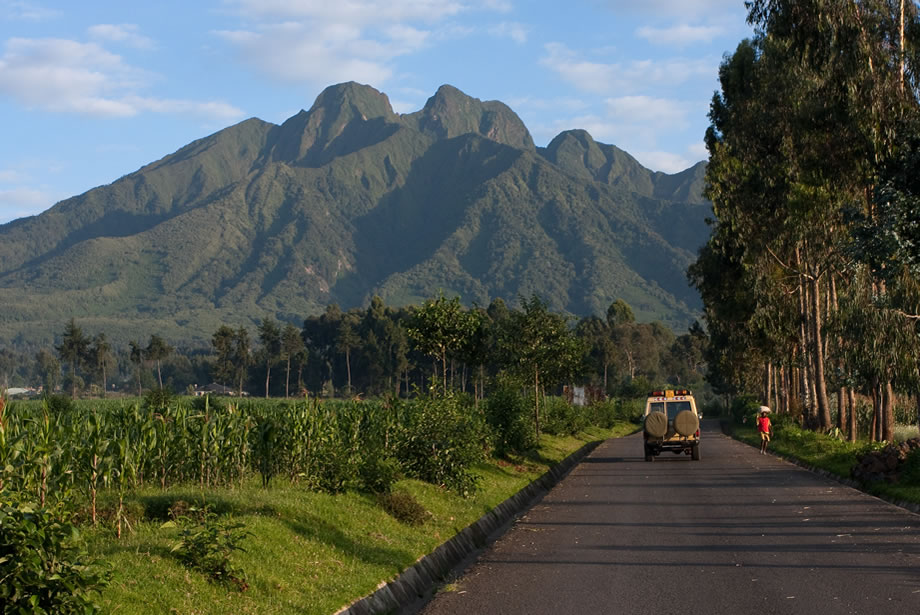Mountain Gorillas live at high altitude in Volcanoes National Park. Mountain gorillas are the world’s most endangered great ape and only found in protected forest countries in Southwest Uganda, North western Rwanda and Eastern Congo (DRC). There are currently ten habituated gorilla families in Rwanda. A maximum of eight visitors per day can visit each family and viewing time is limited to maximum one hour. Gorilla trekking involves walking long distances through thick vegetation, up steep, wet and muddy terrain. This may cause difficulties for some visitors. We recommend you pace yourself; walk slowly and drink plenty of water. No one should feel deterred from making this trip.
Volcanoes national park is the Rwandan section of the great volcanic massif called the mountain gorillas making Rwanda probably the best place in Africa for a tracking safari. Volcanoes national park has a historical connection with gorilla conservation and it was also the base for the ground- breaking work of primatologist late Diana Fossey that started in the late 1960s and is portrayed in the books and films of gorillas in the mist.
Permit cost: The cost for one permit is US$1500 the permits are in extremely short supply and are often booked up as early as 18 months in advance. Only persons over the age of 15 are allowed to track the gorillas.
When to visit: Gorilla tracking all year-round activity, with no season as such. The forest is moist and it rains quite often in Rwanda Volcanoes National Park, even in the dry season. Trekking starts every morning from the park headquarters at 8:30 AM. The gorilla location trackers will use their knowledge of the gorillas’ habits and information from the previous day to locate the group’s whereabouts and their job is to locate the gorilla group before you head on your trek so that your guide is able to take you directly to them.
Weather conditions:
The climate in the Virungas is typically damp, with daytime temperatures averaging 50°F (10°C).
Dry Season: June to September and January and February are the driest months and best for gorilla trekking, but be prepared for afternoon thunderstorms at any time.
Rainy Season: The long rains are from mid-march to mid-May, when many roads become impassible. It also usually rains in October and November.
Clothes and supplies for trekking
- A small, lightweight, frameless, waterproof back/day pack.
• Light, waterproof hiking boots or shoes with treaded soles.
• Thick socks and gaiters to wear over your pants and shoes.
• Leather or heavy canvas (gardening-style) gloves for moving through the vegetation and especially avoiding any contact with stinging nettles.
• Waterproof rain pants and top with hood.
• Short sleeved shirt or T-shirt.
• Long pants to be put on under the rain pants should be the light-weight trekking variety. Many just wear their lightweight rain pants instead of trousers.
• A waterproof, squash-able hat.
• Bottles of water (bring more than you think you’ll need),
• Energy bars or other high-energy snacks to keep you fueled.
Gorilla trekking process: As you set off from the starting point, your guide will lead you to the trek to find the early morning trackers who have set off at first light separately from you and your guide and likely have already located the gorilla family. Your group’s lead tracker will have his own gorilla family, which he visits each day and whose home range and travel routes are familiar to him. All trackers are experienced in looking for signs of the gorillas, such as footprints, dung, chewed bamboo and celery stalks, and abandoned nests from the previous evening. On days of heavy rain, it is more difficult to distinguish signs of the gorillas and the age of nests.
Your guide will allow you time to stop and rest along the trail; however, they tend to hike at a steady, for they must be mindful of the time to ensure that you will be able to reach the gorillas, spend a full hour with them, and make it back down the trail before dark. If you occasionally lag behind the group to take photos or are having difficulty negotiating a steep or slippery portion of the trail, your porter will stay with you to assist; but the group will most likely continue forward.
Your trekking group will be instructed to stay together and come down while observing the gorillas so that the dominant male can see you at all times and the family does not feel threatened, surrounded, or overwhelmed. Never stare directly into the eyes of a gorilla, for a fixed stare is as aggressive to them as it is to most humans. Despite the temptation to run, you must stand your ground, maintain a subordinate, crouching position, and do your best not to flinch for the gorilla will stop before actually reaching you and calmly return to his previous location, glancing back at you with smug satisfaction.
Your trekking group will spend up to one hour with the gorillas on each excursion. This time limit is carefully observed and protects the gorillas from undue stress. Although they are getting used to being visited regularly and are curious about their human visitors, they are accustomed to one-hour visits and their intensely shy and private nature will reassert itself in the end.
You should keep in mind that gorillas are shy, wild animals. At the start of the trekking day, there is no way of telling exactly where the habituated gorilla families are (even though trackers are very skilled at looking for signs of gorillas and their paths of travel). Also, because gorillas are wandering animals that favor areas of dense vegetation, consistent, clear viewing at close range cannot be guaranteed.
After your gorilla experience, you return to the headquarters for your gorilla tracking certificates.

Leave a Reply